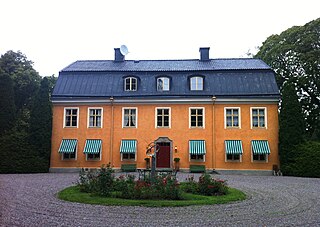Related Research Articles

Pär Fabian Lagerkvist was a Swedish author who received the Nobel Prize in Literature in 1951.

Eric IX,, also called Eric the Holy, Saint Eric, and Eric the Lawgiver, was a Swedish king in the 12th century, c. 1156–1160. The Roman Martyrology of the Catholic Church names him as a saint memorialized on 18 May. He was the founder of the House of Eric, which ruled Sweden with interruptions from c. 1156 to 1250.

Signhildsberg is a manor that formerly was a royal estate, located in the parish of Håtuna approximately 4 kilometres (2.5 mi) west of the modern town of Sigtuna, by Lake Mälaren in Sweden. Although the location is nearly forgotten, it has a central role in Norse mythology, according to which it was founded by the Norse god Odin.

Sara Lidman was a Swedish writer.

The National Archives of Sweden is the official archive of the Swedish government and is responsible for the management of records from Sweden's public authorities. Although the archives functions primarily as the government archive, it also preserves some documents from private individuals and non-public organizations. The mission of the archives is to collect and preserve records for future generations.

Nils Artur Lundkvist was a Swedish writer, poet and literary critic. He was a member of the Swedish Academy from 1968.

Early Swedish literature designates Swedish literature written between approximately 1200–1500 AD.
The Eric Chronicle is the oldest surviving Swedish chronicle. It was written by an unknown author between about 1320 and 1335.
Philosopher's stone is a term for the legendary goal of Western alchemists.

Johan Hadorph was a Swedish director-general of the Central Board of National Antiquities.
The Karlamagnús saga, Karlamagnussaga or Karlamagnus-saga was a late-thirteenth-century Norse prose compilation and adaptation, made for Haakon V of Norway, of the Old French chansons de geste of the Matter of France dealing with Charlemagne and his paladins. In some cases, the Karlamagnús saga remains the only source for otherwise-lost Old French epics.

There are grooves carved into rock in many places in Europe, and some of them appear on the Baltic Sea island of Gotland. They are common in France, where they were used to polish stone axes.

Carl David af Wirsén was a Swedish poet, literary critic and the Swedish Academy's permanent secretary 1884–1912.
The Bure kinship is a Scandinavian kinship, centered largely in the Skellefteå and Bureå areas in Northern Sweden.

Karl Gunnar Harding is a Swedish poet, novelist, essayist and translator, considered 'one of Sweden's foremost poets'. Among his other poetry collections is Starnberger See from 1977. Among his novels is Luffaren Svarta Hästen from 1977. He published the children's book Mannen och paraplyet in 1990. He was awarded the Dobloug Prize in 2011.

Harry Järv was a Finland Swedish librarian, author and translator. He was a lieutenant ranked veteran of World War II. By his political views Järv was an anarcho-syndicalist.
The Eufemiavisorna are a group of three medieval romances translated into medieval Swedish: Herr Ivan lejonriddaren (1303), Hertig Fredrik av Normandie, and Flores och Blanzeflor. They are known in Swedish as the Eufemiavisorna, 'the Euphemia poems' or, less commonly, Eufemiaromanerna, 'the Euphemia romances'; they are known in Norwegian (bokmål) as the Eufemiavisene and in Danish as Eufemiaviserne. The romances are an early example of the poetic form known as Knittelvers; are the first known Scandinavian renderings of Continental European chivalric romance in verse; and are one of the first major works of literature in Swedish.
"Elveskud" or "Elverskud" is the Danish, and most widely used, name for one of the most popular ballads in Scandinavia.
Riddles are widely attested in post-medieval Scandinavian languages, though the traditional, oral riddle fell out of widespread use during the later twentieth century, being replaced by other oral-literary forms, and by other tests of wit such as quizzes.
Erik Anders Burius, was a Swedish intellectual historian and director of the National Library of Sweden's manuscript department where he became known as the infamous "KB-mannen" after the theft and sale of several valuable books from the library's collection.
References
- 1 2 3 4 Stephen A. Mitchell, 'Spirituality and Alchemy in Den vises sten (1379)', in Lärdomber oc skämptan: Medieval Swedish Literature Reconsidered, ed. by Massimiliano Bampi and Fulvio Ferrari, Samlingar utgivna av Svenska fornskriftsällskapet, serie 3: Smärre texter och undersökningar 5 (Uppsala: Svenska fornskriftsällskapet, 2008), pp. 97-108. ISBN 9789197611824.
- ↑ Stephen A. Mitchell, Witchcraft and Magic in the Nordic Middle Ages (Philadelphia: University of Pennsylvania Press), pp. 62-63.
- ↑ Alaric Hall, review of Lärdomber oc skämptan: Medieval Swedish Literature Reconsidered, ed. by Massimiliano Bampi and Fulvio Ferrari, Samlingar utgivna av Svenska fornskriftsällskapet, serie 3: Smärre texter och undersökningar 5 (Uppsala: Svenska fornskriftsällskapet, 2008), Leeds Studies in English, 40 (2009), 153-55 (p. 155).